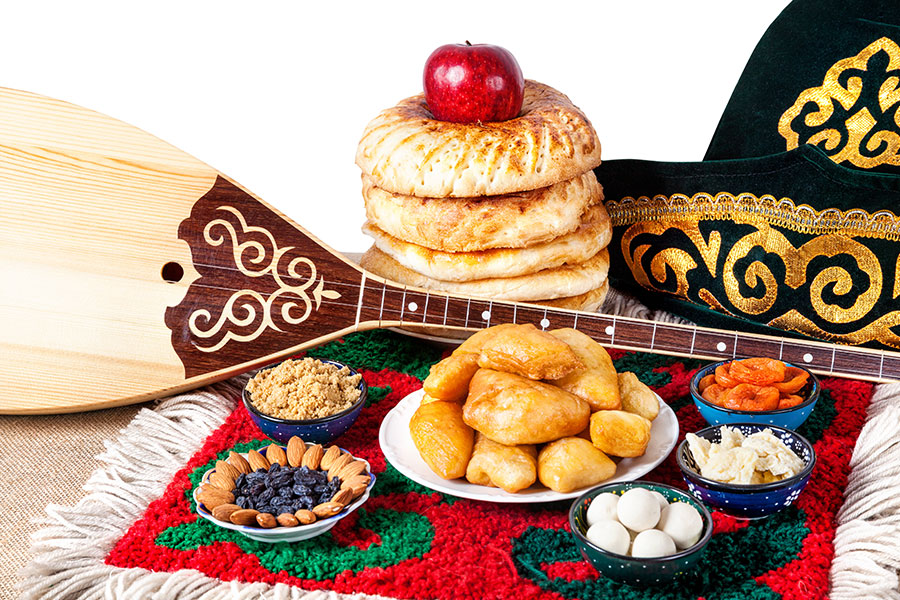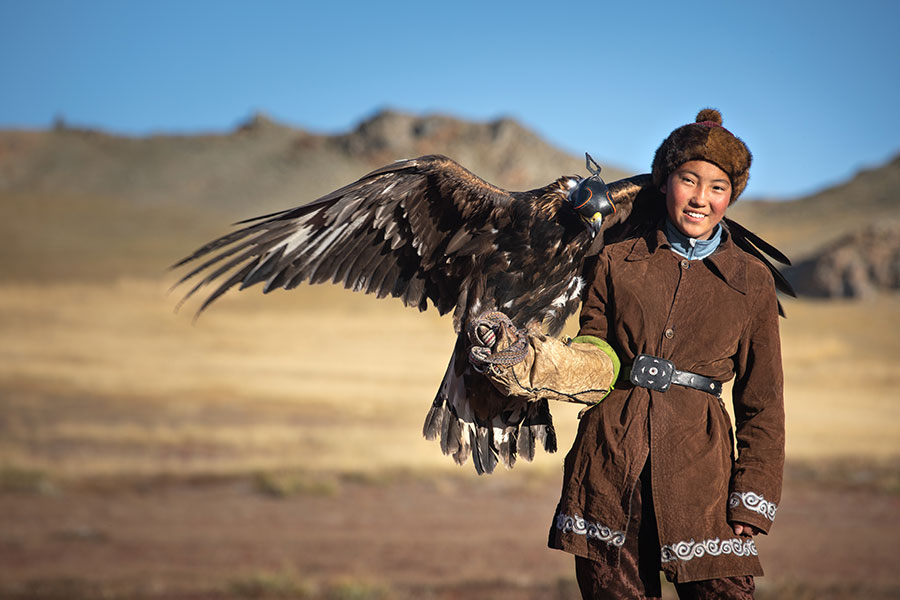
Many of Kazakhstan's intangible cultural heritage sites recognized by UNESCO have centuries-old origins. Rooted in the nomadic lifestyle of the steppe, Kazakh culture has been preserved through traditions and customs passed down from generation to generation. This rich heritage includes games, arts, and many other elements that have survived to the present day. The UNESCO List of Intangible Cultural Heritage in Kazakhstan features 13 sites.
UNESCO Intangible Cultural Heritage in Kazakhstan:
- Traditional knowledge and skills in making Kazakh yurts (Turkic nomadic dwellings) (included in the Oral and Intangible Cultural Heritage of Humanity in 2014),
- Kazakh traditional art of Dombra Kuy (included in 2014),
- Aitysh/Aitys, art of improvisation (included in 2015),
- Nauryz, an ancient holiday (included in 2016),
- Kuresi wrestling (included in 2016),
- Flatbread making and sharing culture: Katyrma (included in 2016),
- Kazakh traditional Assyk games (included in 2017),
- Traditional spring festive rites of the Kazakh horse breeders (included in 2018),
- Heritage of Dede Qorqud/Korkyt Ata/Dede Korkut, epic culture, folk tales and music (included in 2018),
- Traditional intelligence and strategy game: Togyzqumalaq, Toguz Korgool, Mangala/Göçürme (included in 2020),
- Falconry, a living human heritage (included in 2021),
- Telling tradition of Kozhanasyr Anecdotes (included in 2022),
- Orteke, traditional performing art in Kazakhstan: dance, puppet and music (included in 2022).
Traditional knowledge and skills in making Kazakh yurts
This cultural value is also recognized by UNESCO in Kyrgyzstan. A yurt is a nomadic dwelling that can be easily assembled and disassembled when relocating. Scholars debate the origins of the first yurts, with some suggesting dates as early as the 12th or 9th century B.C., and others proposing the 8th or 5th centuries B.C. Today, yurts are used by shepherds who take their livestock to pasture for several months, as well as by tourists. The yurt is a symbol of family, hospitality, and Kazakh national culture.
Kazakh traditional art of Dombra Kuy
The dombra, often referred to as the soul of the Kazakh people, is a pear-shaped, plucked, stringed musical instrument with two strings. Its prototype dates back more than 2,000 years. Kyu is an ancient Kazakh art form consisting of traditional instrumental compositions. Dombra kyuis are typically accompanied by historical narratives.
Aitysh/Aitys, art of improvisation
Kazakhstan shares this genre of oral folk art with Kyrgyzstan. Aytys involves two improvisational poets competing against each other, accompanied by the dombra. They can recite poetry or sing, with the main focus being to debate current topics while incorporating humor, wit, and philosophy.
Nauryz
This traditional New Year's celebration is also recognized by UNESCO in Afghanistan, India, the Islamic Republic of Iran, Iraq, Kyrgyzstan, Uzbekistan, Pakistan, Tajikistan, Turkmenistan, and Turkey. Nauryz is a festival of fertility and human values. Before Nauryz, it is customary to clean the house, plant flowers and trees, set a bountiful table, invite guests, and visit others. The main dish of Nauryz, Nauryz-kozhe, consists of seven ingredients: water, milk, flour, cereals (wheat, rice, or corn), meat, fat, and salt.
Kuresi wrestling
Kures is a traditional Kazakh wrestling sport, where the main goal is to put an opponent on their back. Kazakh folklore tells of baluans (strongmen) who practiced kures and were known for their courage and strength. Folk epics, poems, and literary works have been created about them.
Flatbread making and sharing culture: Katyrma
Other types of national bread have been recognized by UNESCO in Azerbaijan, the Islamic Republic of Iran, Kyrgyzstan, and Turkey. Khatirma is a type of bread made from thinly-rolled dough, and usually, the entire family participates in its creation. Katyrma is an integral part of all meals, both festive and memorial. It is customary to break the flatbread by hand without using a knife during feasts. As part of the tradition, the person who breaks the katyrma offers wishes to those present.
Kazakh traditional Assyk games
Asyk is one of the most ancient games of the Kazakh people, played by nomads for many centuries. Scientists believe that the game originated in the 1st millennium BC. To play Asyk, players need a small part of a sheep, ram, or goat bone, located between the shin and tibia. The game strengthens and sometimes creates friendships, bringing people together regardless of age.
Traditional spring festive rites of the Kazakh horse breeders
These amazing rites take place in Terisakkan village of Ulytau district of Karaganda region. They are based on centuries-old traditions of human interaction with horses. During Biye bailau there is a rite of the first milking of mares that have given birth. During Aigyr kosu the new stallions join the herd to give birth to the new herd. Kymyz muryndyk is the first koumiss exchange, which marks the beginning of a new season of mare's milk production.
Heritage of Dede Qorqud/Korkyt Ata/Dede Korkut, epic culture, folk tales and music
This culture is also under the auspices of UNESCO in Azerbaijan and Turkey. Korkyt Ata, who lived on the shores of the Syr Darya River in the ninth century, was the inventor of the kobyz (musical bowed instrument) and the founder of musical works called kyuis. There are legends that Korkyt Ata wanted to become immortal and the kobyz gave him such an opportunity. The airport, an international festival, educational institutions and streets in Kazakhstan are named after Korkyt.
Traditional intelligence and strategy game: Togyzqumalaq
This game has also been included in the UNESCO representative list for Kyrgyzstan and Turkey. In the past, it was played in specially dug holes, but today, Toguz Kumalak is a board game. Translated from Kazakh, the game's name means "nine pebbles." The number nine has long been considered sacred by Turkic peoples. Togyz Kumalak helps improve mathematical thinking while developing logic and intelligence.

Falconry, a living human heritage
Falconry is also on the UNESCO list for over a dozen countries, including Austria, Croatia, the Czech Republic, France, Ireland, Poland, Portugal, Spain, and the United Arab Emirates, among others. In Kazakhstan, this type of hunting has been practiced for 4,000 years. The earliest rock image of falconry found in Kazakhstan dates back to the 1st millennium BC.
Telling tradition of Kozhanasyr Anecdotes
Kazakhstan shares this type of cultural heritage with Azerbaijan, Kyrgyzstan, Tajikistan, Turkey, Turkmenistan, and Uzbekistan. The Kazakh character Kozhanasyr (or Apendi) is better known worldwide as Khoja Nasreddin. He is a folklore hero who often finds himself in humorous situations and escapes them using his wisdom and life experience. Stories about Kozhanasyr have been passed down orally for many centuries.
Orteke, traditional performing art in Kazakhstan: dance, puppet and music
Orteke is a puppet-musical theater art form in which a musician-puppeteer controls a wooden figure of a mountain goat called tauteke. As the musician plays the dombra, the doll, tied to their left hand, "comes to life" and starts beating the rhythm on a traditional Kazakh drum.
It's nearly impossible to visit Kazakhstan without encountering some of the UNESCO intangible heritage sites. For instance, there is a 99% chance that you'll be invited to a yurt and shown some falconry.
Intangible UNESCO World Heritage Sites in Kazakhstan offer valuable experiences that will captivate even the most seasoned travelers.
Learn more about tangible UNESCO World Heritage Sites in Kazakhstan.

